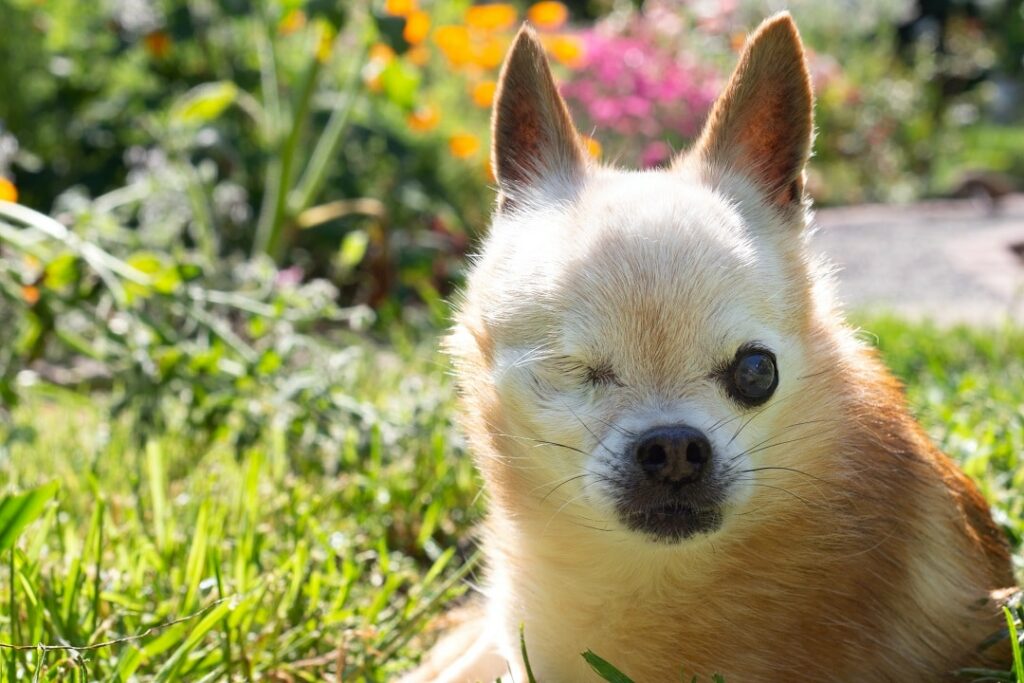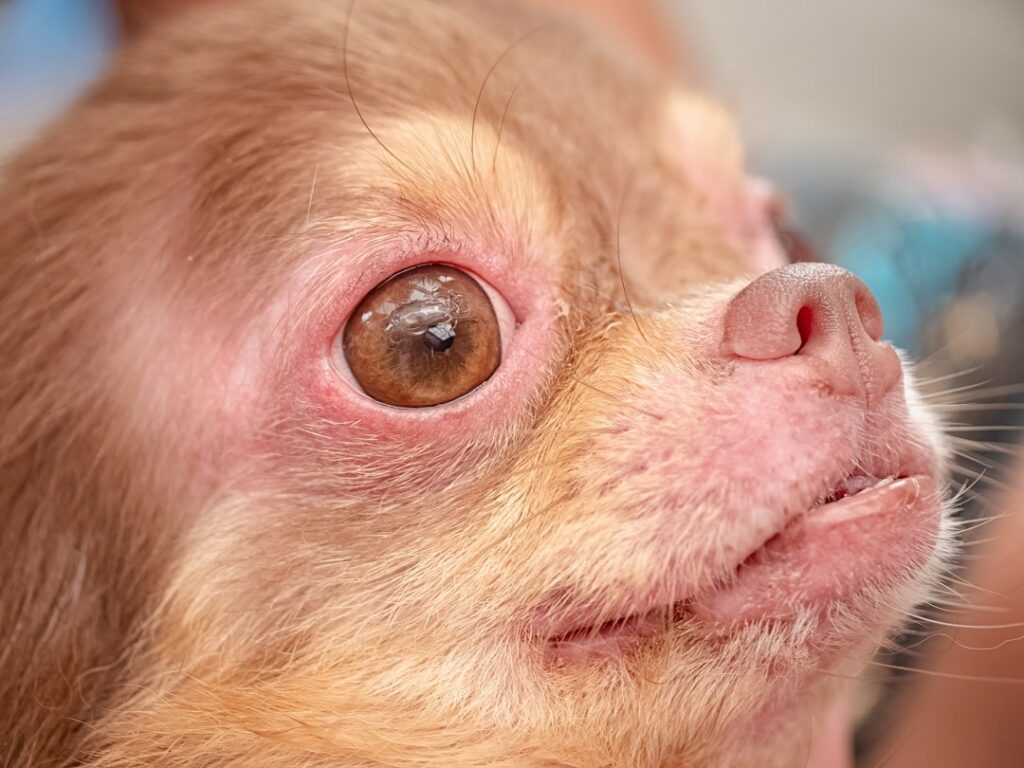Chihuahuas typically live 13-15 years. Some live even longer, though they’re usually quite decrepit by then.
Accidents and Injuries
Accidents and Injuries happen to Chihuahuas more than illnesses and diseases.

- Jumping from high furniture or from your arms can cause fractures or a concussion. Many Chihuahuas slip between the slats of a stairwell railing or raised deck and fall off. If your kids are throwing or kicking a ball around, a Chihuahua can be seriously hurt if he’s in the wrong place at the wrong time.
- Because of their slender throat, Chihuahuas can choke on things that a bigger dog would simply swallow. So scan your floors for tiny objects. Similarly, ingesting even a little tiny bit of something toxic (like chocolate, raisins, or grapes) can harm a Chihuahua when it would be okay for a larger dog.
- Speaking of larger dogs, they can injure a Chihuahua by accident, just by bouncing around. Imagine if you were just standing there and a creature – even a friendly creature – suddenly jumped and landed on you…. and was 20 times your weight!
- You need to keep a Chihuahua safely on a leash or in a fenced area. This is not an off-leash breed that should be wandering around the park with you. Too many bad things can happen to a tiny dog.
Open molera and hydrocephalus
We decided to cover this one high on the list because there’s so much misunderstanding about it.
Sometimes vets who know little about Chihuahuas will frighten a new owner by warning them, “Your Chihuahua has an open molera (a soft spot on his head), which means he could get hydrocephalus (accumulation of fluid on the brain).”
Relax. It isn’t true. Yes, Chihuahuas can have hydrocephalus, but it’s not connected to their molera.
What is a molera?
Like human babies, Chihuahua puppies are born with a skull that is slightly open – just a little gap. It’s called the molera (mo-LAIR-ah) or fontanel (fon-tun-ELL), and it makes the skull more flexible so that the big head can slide more easily through the birth canal.
Yuck! Can you see their brain?
Certainly not. The opening is in the bony skull. Since skin and hair cover the skull, you can’t even see the hole, never mind the brain. Press lightly on the top of a Chihuahua’s head. If you feel a soft spot with no skull bone beneath it, that’s the molera. It might be roundish or oblong.
Soon after a puppy is born, the molera may close. Or it may stick around for a few months or years, then close. Or it may shrink in size, but remain open throughout the dog’s life.
You might be thinking, “That’s dangerous, isn’t it? What if something hit their soft spot? Would it kill them?”
I would be more concerned about that if the molera was very large (much larger than a quarter) or if there were multiple moleras.
But practically speaking, you need to take great care around Chihuahuas anyway. A dictionary dropped on a Chihuahua’s head will probably kill him whether it hits the soft spot or not. A bratty kid who jabbed a pencil through the molera could just as easily have jabbed it through an eye. You don’t want to hit or hurt a Chihuahua on any part of their body.
The good news is that an open molera is simply a typical trait of the breed. Veterinary researchers have found no correlation between an open molera in Chihuahuas.
Hydrocephalus
Hydrocephalus (hydro-SEF-eh-luss) is a build-up of cerebro-spinal fluid within the brain. This can occur in Chihuahua puppies, but it’s not associated with whether a pup has an open molera or not.
Typically these pups will have several of these symptoms:
- a huge domed head
- bulging or pulsating in the molera
- wide-set eyes, eyeballs looking out to the side instead of straight ahead, a lot of white showing on the inside corners of the eyes
- slowness in learning
- incoordination, difficulty running and jumping
- seizures
- general failure to thrive and grow – often the pup reaches a couple of pounds, then stops growing and doesn’t do particularly well
Hydrocephalus is usually apparent by four months of age. Many puppies don’t even make it that far and simply pass away in their sleep. Those with mild hydrocephalus may live longer. There is no cure, though surgery to relieve the pressure on the brain is a possibility.
Dental disease
When people deliberately breed dogs to be tiny, there usually isn’t enough room in their mouths for strong healthy teeth.
In Chihuahuas, you often see crooked teeth pointing inward or outward, crammed too close together, wiggly instead of firmly seated in the gum, and/or coated with plaque and tartar.
Teeth problems are not just a minor thing. Bad teeth hurt when your Chihuahua chews. Loose teeth, or teeth too close together, provides a hiding place for bacteria to grow, leading to bad breath and infections, which can travel through the blood to the kidneys or heart.

You really don’t want to be taking your Chihuahua to the vet every year to be put under general anesthesia to pull rotten teeth.
So it’s important to brush your Chihuahua’s teeth every week. Use a soft moistened cloth and an enzymatic toothpaste made especially for dogs. Human toothpaste often has ingredients that are toxic to dogs.
If you have a steady hand and you’re comfortable with sharp tools, you can use a dental scraper to scrape tartar off before it has a chance to work its way under the gumline and cause decay and infection.
Orthopedic disorders
Knee problems
Like many other toy breeds, Chihuahuas are prone to loose knee joints. In case you’re wondering, the knees are on the rear legs. The front edge of the leg, the curved part.
When a Chihuahua inherits loose knee joints, the kneecap can pop out of its socket. The official name is the luxating patella, which means dislocating kneecap.
Luxating patella can affect just one rear leg or both rear legs. It can be mild, causing temporary occasions of lameness as the knee pops out and then back in again. Or it can be crippling and require expensive surgery.

Hip problems
Chihuahuas are also more vulnerable to two degenerative hip diseases that are quite serious: Legg-Calve-Perthes disease and hip dysplasia. Many people think of hip dysplasia as affecting large dogs, but it affects many toy breeds, as well.
Liver shunt
An abnormality called a liver shunt is pretty common in Chihuahuas. The liver is one of the organs in the digestive system. Its job is to remove toxins from the bloodstream. Toxins are waste by-products that are produced when your dog eats a meal.
Waste by-products are harmless if the liver does its job of filtering and eliminating them.
But when a Chihuahua has a liver shunt, the blood that’s supposed to be filtered through the liver bypasses the liver. That means the waste products aren’t filtered out. Instead, they build up in the bloodstream and have toxic effects on the poor dog’s brain and nervous system.
Sometimes you can manage a mild shunt (just a partial bypass) with a special homemade diet. But usually, a liver shunt requires surgery – tricky, expensive surgery.
Collapsing trachea
The trachea is your dog’s windpipe: the tube through which he breathes. In some tiny breeds, the windpipe can be so weak that it might, on occasion, temporarily collapse in on itself, limiting the amount of air that gets through.
Then you’ll hear your dog cough – a distinctive honking sound like that of a goose.
The collapsing trachea can be hereditary or caused by an injury to the windpipe. Whatever the cause, it’s a serious condition that always gets worse over time. Sometimes surgery can help, but it’s risky surgery that might make things even worse.
Important! Chihuahuas are very, very prone to a harmless “coughing” condition that sounds a bit like a collapsing trachea. Except it isn’t really a cough – it’s actually an odd sneeze that sort of “backfires” on the dog. Hence the name reverses sneezing.
A LOT of Chihuahuas do this – far more than are affected by collapsing trachea. So if your Chihuahua makes this odd snorting/wheezing sound when he’s excited, or during or immediately after eating or drinking, it’s most likely harmless reverse sneezing.
Eye diseases
A Chihuahua’s large eyes are vulnerable to damaging scratches and corneal ulcers.
Occasionally reported are corneal dystrophy (a particularly severe form in Chihuahuas), lens luxation, glaucoma, and dry eye.

Skin and coat diseases
There are three skin conditions to be aware of in Chihuahuas:
- demodectic mange: a parasitic infection that causes hair loss and infections
- color dilution alopecia: a congenital disease in BLUE Chihuahuas
- pattern baldness: not a disease, just a harmless condition
- Demodectic mange
- Demodectic mange is fairly common in young Chihuahuas. Some vets believe that all puppies (in all breeds) are born with a few Demodex mites. A strong immune system keeps the mites in check so they remain harmless.
But in some pups, the mites multiply into the skin condition called demodectic mange. The symptoms are very specific: hair loss near the eyes and mouth and on the front legs – no itching or risk of contagion. (A different type of mange, sarcoptic mange, is both itchy and contagious.)
Demodectic mange usually flares up during some type of stress that weakens the immune system.

A Chihuahua can become stressed from illness, surgery, a long car or plane ride, or relocating to a new home. This is one of the many reasons why Chihuahuas should not be sent to a new home until they’re at least 10 or preferably 12 weeks old when their immune system is more developed.
Fortunately, most cases of demodectic mange in Chihuahuas remain on the head and legs and usually fade away even with no treatment. This is called localized demodex.
The more serious version, general demodex, spreads all over the body. This used to be a death sentence, but with medicated baths and antiobiotics, it can now be treated. However, these medications are harsh and potentially toxic, and the skin and coat of an affected dog seldom return completely to normal.
Color dilution alopecia (in blue Chihuahuas)
This hair loss disease occurs in quite a number of blue Chihuahuas.
Why blues? Because, unlike black or white or brown, blue is not a normal color in dogs. There is no gene labeled blue. Rather, blue is the result when a dog inherits a normal black gene, plus a dilution gene that washes the black into a grayish shade, anywhere from silvery to charcoal.
Dog fanciers call it blue.
I guess it kind of looks blue.
Unfortunately, there is a skin problem associated with dilution genes. It’s called color dilution alopecia. Alopecia means hair loss. The symptoms are a gradual thinning or loss of the blue hair, plus nodules (bumps) on the skin, and repeated bacterial infections.
This disease is almost an epidemic in some breeds, such as blue Doberman Pinschers. It’s less common and less serious in Chihuahuas, but you still should be very cautious when acquiring a blue Chihuahua puppy.
CDA is a lifelong condition, but the coat can be improved with a special homemade diet and supplements, and special baths.
Does every blue Chihuahua have this? No.
- If neither of your puppy’s parents is blue, a blue puppy is much less likely to have inherited the disease.
- If one parent is blue, look closely at that parent’s coat and skin.
- If both parents are blue… shame on that breeder! Educated breeders will not breed blue-to-blue, as the risk of skin problems in those pups is so great.
You can also look at the shade of blue. Light silvery blues are the most common victims, while dark blues are more likely to have a healthy coat.
To sum up then, a dark blue Chihuahua from non-blue parents (or from one blue parent with an excellent coat) is generally quite safe. But there are no guarantees one way or the other.
Pattern baldness
Pattern baldness isn’t really a disease, but I’m mentioning it because quite a lot of Chihuahuas have it. Pattern baldness is a gradual thinning or complete loss of hair around their temples, ears, throat, and stomach.
It’s not itchy and the skin and coat are otherwise normal. Since it’s only a cosmetic condition, there’s no treatment required other than adding supplements that are good for the skin and coat, such as a fatty acid supplement.

Heart disease
Heart diseases (especially patent ductus arteriosus and mitral valve disease) are occurring more frequently in Chihuahuas.
PDA occurs in young Chihuahuas, might be manageable with medication, or might require major surgery.
Mitral valve disease usually occurs in older Chihuahuas and can be managed with medication.
Both diseases can be detected by a heart murmur, so make sure your vet listens carefully to your Chihuahua’s heart whenever you’re in the vet’s office for anything.
Hypoglycemia
If you have a Chihuahua puppy or an adult Chihuahua under 3 pounds, you should be watchful for episodes of low blood sugar, also known as hypoglycemia.
Blood sugar (glucose) is essential for the brain and body to function normally. If blood sugar drops too low, a tiny dog might become weak and wobbly, or might curl up in a ball and fall asleep right in the middle of a play session, oblivious to the busy activity going on around him.
Low blood sugar needs to be treated immediately, else it can progress to seizures or a hypoglycemic coma. Every Chihuahua owner should keep a tube of Nutrical in their cupboard. Nutrical is a high calorie, high sugar, high energy supplement. It’s inexpensive and can save a Chihuahua’s life.
At the first sign of weakness or lethargy, offer a generous fingerful. Most Chihuahuas like the sweet taste and will lick it right off your finger. Otherwise just stick it inside his mouth, wiping it onto the roof of his mouth to stimulate his swallowing reflex.
In an emergency, if you don’t have Nutrical, try a tsp of honey or vanilla ice cream.
Preventing health problems
Some health problems are inherited. For example, if both parents of your Chihuahua have certificates proving they were tested and cleared of luxating patella, your Chihuahua has less risk of developing it.
Other health problems can be prevented, or partially prevented, by the ways you raise your dog.
Good luck on keeping your dog healthy, leave us comments below.






